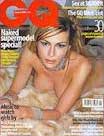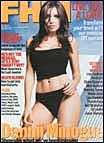
For those of you who are old enough to remember the pre television days, you will know well the importance of magazines like Life, Time and Newsweek, but there was also Saturday Evening Post, Look and many others that brought both words and pictures into your hands and into your mind. The images on those pages shaped our view of the world and set the standards for what a picture should look like. As a young teacher, I had a Life subscription and kept them all, savouring the marvels of the places and the quality of those pictures. Pictures that involved the viewing in the event.
Things have changed, not only does television bring us those images that fuel our imagination, but we now have the Internet that takes us even further in, revealing that world beyond. The transformation of the news stand has never been so dramatic as it is right now. From the late forties to the seventies there were gradual changes in what was presented to the public and the seventies saw whole sections of news stands devoted to material that was definitely not family oriented. Remarkable changes in society were taking place and the print material reflected those changes. From the seventies until a year ago, things were pretty much a constant, but the effects of the Internet began to kick in and today's offering is the result.
From the beginning of the printing press there were always publications that catered to every level of consumer. Fictional dramatisations of what may be real events were very popular before photography and in the fifties the "crime" and "romance" magazines filled the news stands. I remember the snickering around the Co-op store news stand when a guy named Hugh Heffner put out his first issue with a naked picture of Marilyn Munroe in the centre of it, George McClement caught Billy and I, wide eyed checking that out, and chased us out of the store. Playboy was a sort of landmark in North American popular culture. Unclothed people were being photographed and displayed in a glossy magazine instead of on the walls of art museums. The sixties saw this trend expand and degrade as more publications attempted to capture this lucrative market because of the demand for these magazines, advertisers paid heavy money to display their products along side naked bodies. The seventies saw Penthouse, and a whole confusing bunch of these things that were clearly just pornography like Hustler that made no effort whatever to claim to have quality with in their sleazy c
 overs.
overs.Then something snapped, the public began to shun the news stands altogether and the owner of the 7-11 chain realised that there was money to be made in magazines so he banned Playboy, Penthouse and the rest. The market improved.
So what are we looking at now? The dramatic trend in publications is amazing as advertisers and publishers scramble to meet the challenge of this wired world. The public is not interested in extremes, for those who want the extreme there is their computer system, but to hold in your hands and let your mind wander, the publishers have gone for flash and show. Actresses, celebrities,
 pretty people, are put on the covers and the headlines
are steamy, promising cautious tintilation. I am not going to tell you what is in
these publications or attempt to review them, because quite honestly, I have just
noticed they existed and I have never picked one up, I just am overwhelmed at the
covers.
pretty people, are put on the covers and the headlines
are steamy, promising cautious tintilation. I am not going to tell you what is in
these publications or attempt to review them, because quite honestly, I have just
noticed they existed and I have never picked one up, I just am overwhelmed at the
covers.It would seem that the publishers, GQ is actually produced by
 Penthouse,
have spotted a new way of being naughty, and added some class and style to their
publications to let them be part of what is becoming the main stream. The cover of
this month's Gear magazine features a teenage star of a television show who
wanted out of her contract and to do so appeared on the cover of this magazine as
you can see her on the left.
Penthouse,
have spotted a new way of being naughty, and added some class and style to their
publications to let them be part of what is becoming the main stream. The cover of
this month's Gear magazine features a teenage star of a television show who
wanted out of her contract and to do so appeared on the cover of this magazine as
you can see her on the left. This trend toward these remarkably tame men's magazines was lead by the
 magazine Maxim
which was one of the first to get itself out to the market place and is enjoying
remarkable success. This current issue pro ports to give you the pictures of bathing
suits and of course those wearing them, without the pretense of all that sports stuff.
(A reference to the major slick American Sports Illustrated that each year
comes out with its "Swim suit edition") I was quite surprised to find that
most of these trendy publications have been around a bit longer in Britain and even
though they have the same names, they produce European and North American editions
that are directed toward the specific nature of the marketplace. The GQ cover
on the left is this month's European version.
magazine Maxim
which was one of the first to get itself out to the market place and is enjoying
remarkable success. This current issue pro ports to give you the pictures of bathing
suits and of course those wearing them, without the pretense of all that sports stuff.
(A reference to the major slick American Sports Illustrated that each year
comes out with its "Swim suit edition") I was quite surprised to find that
most of these trendy publications have been around a bit longer in Britain and even
though they have the same names, they produce European and North American editions
that are directed toward the specific nature of the marketplace. The GQ cover
on the left is this month's European version.After all these publications are in fact pure marketing tools. Sex sells and if you are selling some product these
 publications are where you are going advertise your products, provided
your intended market is a late teenager male or in his twenties.
publications are where you are going advertise your products, provided
your intended market is a late teenager male or in his twenties. The advertisers of today
are faced with massive problems. The rules and the marketplace has all changed, television
is now so diffuse that it is really difficult to hit a wide audience and the targetted
audiences produced by cable and multiple channel viewing is afflicted by remote control
devises that zap your message relentlessly. Print publications like Time and
Newsweek no longer command the respect they once did as they are publishing
"old news" as the educated reader more and more keeps up to date with CNN
and the Internet. This makes magazine advertising extremely attractive to the mass
marketing company. They can hit their consumer target accurately and it is comparatively
speaking, a cheap form of advertising.
The advertisers of today
are faced with massive problems. The rules and the marketplace has all changed, television
is now so diffuse that it is really difficult to hit a wide audience and the targetted
audiences produced by cable and multiple channel viewing is afflicted by remote control
devises that zap your message relentlessly. Print publications like Time and
Newsweek no longer command the respect they once did as they are publishing
"old news" as the educated reader more and more keeps up to date with CNN
and the Internet. This makes magazine advertising extremely attractive to the mass
marketing company. They can hit their consumer target accurately and it is comparatively
speaking, a cheap form of advertising.It just so happens that in our local 7 - 11 the lay out is such that the news stand is divided up into areas, wrestling and body building, these pop semi-tease girlie magazines, computers and science, cars, motorcycles and sports. The on an opposite aisle are the ladies magazines which includes, glamour, fashion, crafts, trendy home making, romance, teenage girl music and pop culture and "women's" magazines. It is amazing to see, again just looking at the covers, that there is little difference between the "men's" and the "women's" magazines. The same beautiful women adorn the covers often one month on a male oriented publication and female one the same or next month. The content, at least from the head lines, is geared to female readers, but the subject matter seems pretty much the same and this was not always the case.
This change in what the publishers are presenting to women began with Cosmopolitan which now seems pretty tame compared to the other similar magazines which essentially are written for the apparently "liberated" woman of today. There is no question that some major social and economic revolution has taken place in this world of ours and those magazine covers are telling us that it has happened.
